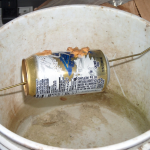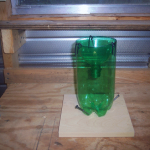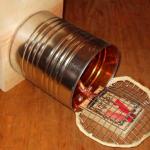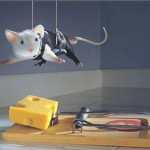Did you know that the standard mouse snap trap wire slams closed in 1/38,000’s of a second? That every year over 400 patents are applied for just for mouse trap inventions?
To date all total there are 4400 patented mouse traps while only about 20 make any money. The first trap was invented back in 1897 by James Henry Atkinson a British inventor and his prototype of the wooden snap trap with springs and wires has not changed much at all since then. In the 1980’s glue boards were invented and widespread use was like a wild fire until people realized that the mouse died a slow and agonizing death, usually squealing and dying from exhaustion. Emerson wrote the famous line;
If a man can write a better book, preach a better sermon or make a better mouse trap than his neighbor, though he builds his house in the woods. The world will make a beaten path to his door. Ralph Waldo Emerson
Actually the message was about quality of workmanship towards success rather than specifically about mouse traps but in either case he has been proven prophetic.
Not do be out done many homeowners have sought to one up Atkinson and start their own 112 year streak of mouse trap dominance. Here are a few of the ideas and you can decide if they’re up to the challenge. Click on the pictures to enlarge and leave a comment as to which one you like or tell us of one of your own.
 The spinning can looks simple enough; run a wire through a beer or soda can and suspend it over a bucket of water. A stick or ruler is placed so he can climb up the bucket and peanut butter is put on the can to entice the mouse. When he gets to the can it spins like a log in water and he falls. Of course the mouse drowns in this scenario but you can leave the bucket empty but you’ll need to release him after he is caught.
The spinning can looks simple enough; run a wire through a beer or soda can and suspend it over a bucket of water. A stick or ruler is placed so he can climb up the bucket and peanut butter is put on the can to entice the mouse. When he gets to the can it spins like a log in water and he falls. Of course the mouse drowns in this scenario but you can leave the bucket empty but you’ll need to release him after he is caught.
The liter bottle trap is promising; Cut a plastic soda bottle 3/4 of the way up and invert the top spout into the base. Secure it with glue or tape and put bait such as peanuts or seed in the hole so it drops to the bottom. Grease the funnel with cooking oil or butter so the mouse gets no grip. Place the trap near a shelf or something so the mouse can jump or climb to the inverted top. Once in the funnel the only way is down, he won’t be able to climb out and you can release him to a safe place. This trap is also useful in that it can double as a fruit fly or gnat trap.
invert the top spout into the base. Secure it with glue or tape and put bait such as peanuts or seed in the hole so it drops to the bottom. Grease the funnel with cooking oil or butter so the mouse gets no grip. Place the trap near a shelf or something so the mouse can jump or climb to the inverted top. Once in the funnel the only way is down, he won’t be able to climb out and you can release him to a safe place. This trap is also useful in that it can double as a fruit fly or gnat trap.
 The modified snap trap approach is a little more difficult to make but can provide good results; A rat snap trap, coffee can, small gauge wire and some hardware cloth with some screws is what you’ll need. First attach the trap to the can by screwing the wood just under the tongue (trigger) to the front of the can. Next cut the cloth about a 1/2 inch bigger than the size of the can. Place the cloth on the back side of the can and mold the edges slightly down around the edges. The concave or protruding side up, use your wire to attach it to the spring loaded snap wire of the trap. The long trigger release arm goes through the cloth and sets the trigger. Test the trap out to make sure the release arm does not block the cloth from covering the entire mouth of the can when it shuts. Bait the back of the can with nuts or peanut butter and set the trap. (you can also attach a board for stability to the back of the can) Catch the mouse alive and release him away from the home.
The modified snap trap approach is a little more difficult to make but can provide good results; A rat snap trap, coffee can, small gauge wire and some hardware cloth with some screws is what you’ll need. First attach the trap to the can by screwing the wood just under the tongue (trigger) to the front of the can. Next cut the cloth about a 1/2 inch bigger than the size of the can. Place the cloth on the back side of the can and mold the edges slightly down around the edges. The concave or protruding side up, use your wire to attach it to the spring loaded snap wire of the trap. The long trigger release arm goes through the cloth and sets the trigger. Test the trap out to make sure the release arm does not block the cloth from covering the entire mouth of the can when it shuts. Bait the back of the can with nuts or peanut butter and set the trap. (you can also attach a board for stability to the back of the can) Catch the mouse alive and release him away from the home.
Well we’ve come along way in mouse traps but as you can see sometimes simpler is better. I’m not sure if any of these will usurp old Henry’s contraption but when you have a mouse infestation who cares, as long as you get your mouse. Before you get to cocky however, consider that the mouse has also had 112 years to study the problem and he hasn’t been sitting idle. Almost all of my mouse calls come after the do it yourself bug man has failed to round up his furry friend and I marvel just how a mouse can escape some of the gauntlets I see. Maybe while we’ve kept to the simple time tested methods the nation of mice have spread the word and gone high tech. My advice? Always call the expert!
sure if any of these will usurp old Henry’s contraption but when you have a mouse infestation who cares, as long as you get your mouse. Before you get to cocky however, consider that the mouse has also had 112 years to study the problem and he hasn’t been sitting idle. Almost all of my mouse calls come after the do it yourself bug man has failed to round up his furry friend and I marvel just how a mouse can escape some of the gauntlets I see. Maybe while we’ve kept to the simple time tested methods the nation of mice have spread the word and gone high tech. My advice? Always call the expert!




